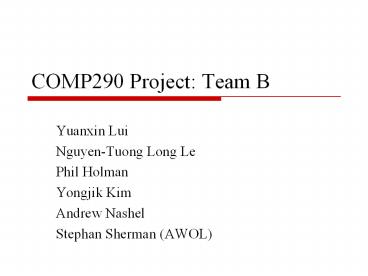COMP290%20Project:%20Team%20B - PowerPoint PPT Presentation
Title:
COMP290%20Project:%20Team%20B
Description:
2. User changes the time frame. 3. Data is received from the TOS server. ... If the TOS is the last in the current time frame, it is passed to the Tracker (5) ... – PowerPoint PPT presentation
Number of Views:23
Avg rating:3.0/5.0
Title: COMP290%20Project:%20Team%20B
1
COMP290 Project Team B
- Yuanxin Lui
- Nguyen-Tuong Long Le
- Phil Holman
- Yongjik Kim
- Andrew Nashel
- Stephan Sherman (AWOL)
2
Overview
- The presentation will consist of 3 parts
- Project design
- Demo of the product
- Comments on the development process
3
Part 1 Design
Status Window
Sequence Window
3PB Tracker
Data Feed
Primary UI Window
Adaptor
Cache
4
Application Structure
- Our design is primarily event-driven.
- Three types of events drive the system
- 1. User changes the stock.
- 2. User changes the time frame.
- 3. Data is received from the TOS server.
5
Event Example
When a new TOS arrives at the Adaptor (1), it is
checked to determine whether it is needed. If so,
the TOS is passed to the Data Feed (2), which
then caches it (3) and updates the Status Window
(4). If the TOS is the last in the current time
frame, it is passed to the Tracker (5). If the
Tracker state changes, then the UI Window is
informed (6) and the Sequence Window is updated
(7) in the event that the change marked the end
of a sequence.
Status Window
Sequence Window
7
4
3PB Tracker
Data Feed
5
2
Adaptor
3
6
1
Cache
Primary UI Window
6
Points of Interest
- We only track (and cache) the last TOS in each
time slot and the opening TOS. All other TOSes
are discarded at the Data Feed. - We use only in-memory caching because there are
fewer than 2000 1-minute time frames in any day,
suggesting that very few TOSes will be cached.
7
Part 2 The Demo
- Insert demo here.
8
Part 3 The Development Process
The development process attempted to follow three
principles
- Emphasize working code over documentation
- Pair programming
- Test-first programming
9
Working code over documentation
- This approach resulted in some additional
overhead when integrating the code. - However, we feel that this approach was
beneficial overall.
10
Pair programming
- Pair programming probably does work well when
both programmers are consistently available each
day to code for a long period of time. - Although we did experience some benefits due to
catching errors early, the overhead due to the
scheduling problems introduced by pair
programming seemed to be more costly. - Even when we did find time to meet, the meetings
were usually limited to at most a few hours.
11
Test-first (TF)
- Test-first programming seemed to hinder
development more than help it. - First, we spent more time correcting errors in
the test than in the code, due to our lack of
experience. - Second, an event-driven design does not require
accessor methods in most objects, but the tests
are difficult to construct without these methods. - Third, assertion-based testing did not seem
appropriate for some objects, such as GUI
components and the Adaptor.
12
Summary(1)
- We will now summarize our observations.
- It is important to note that all members of our
group had little to no prior experience with the
Java language or with these programming
principles.
13
Summary (2)
- We consistently used pair programming.
- However, when the second person had little to
work on, his attention span typically dropped off
quickly. - Pair programming seemed to work well when the
second programmer was actively engaged in some
task, such as looking up an objects API.
14
Summary (3)
- We were unable to use the testing principles as
they were described in class. - In most cases, we were able to use
assertion-based testing with our objects, despite
their event-driven designs. - There was some additional code in the GUI
components that should be tested assertionally,
but would require refactoring first.
15
Tracker as a State Machine
3
2
0
1
2
3































